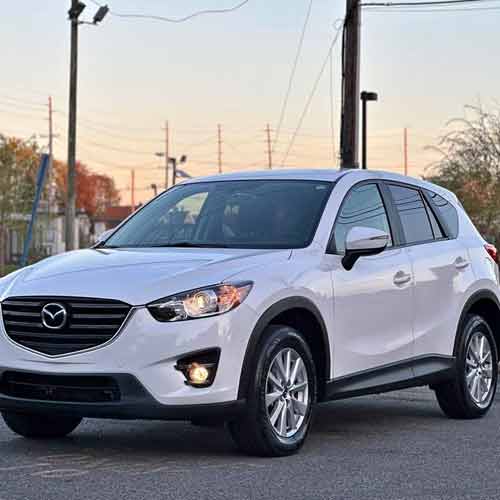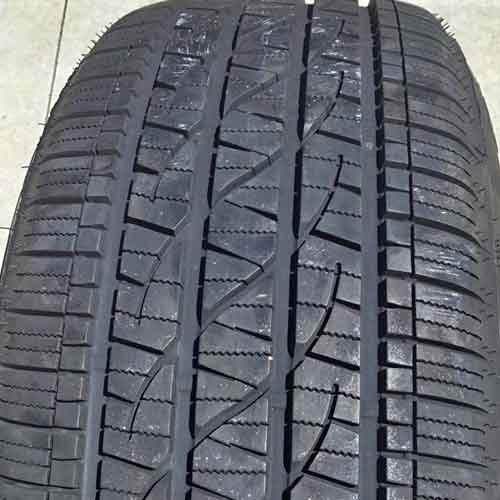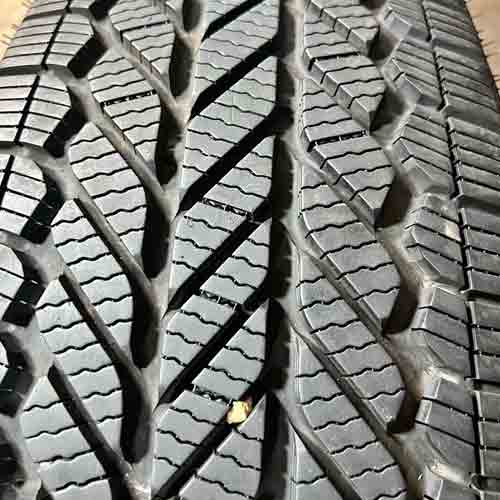The Firestone Destination LE3 comes in highway all-season category (designed mostly for larger vehicles), while Bridgestone WeatherPeak, being a grand touring AS tire offers a great option for family sedans and coupes. Both tires have a lot to offer. Let’s dig in.

So overall, the Bridgestone WeatherPeak offers superior dry performance, (allowing for more effective grip for better braking and handling), improved cornering from it’s direct steering feedback, excellent winter traction, and a more comfortable ride. On the other hand, the Firestone Destination LE3 provides efficient wet traction, maintains a good fuel economy (throughout it’s wear), and is quieter (by a small difference). Also, both tires offer similar tread longevity.
Tread Pattern
The Firestone Destination LE3 comes with a distinctive symmetric tread pattern.

Central to its design are three ribs marked with F and S shaped lugs.
(“S” on the central rib and “F” on the neighboring ones).
These lugs are intricate combinations of lateral grooves and notches, seamlessly connecting the four circumferential channels.
And with better inter-connectivity of grooves, you get pretty decent water clearance abilities.
Moreover, the tire also features chamfered edges, and wave-like siping (though its seen on all ribs).
The shoudler lugs are more streamlined, with their straight longitudinal voids, connecting with notches (facing the middle).
Speaking of its internal construction, the tire is underpinned by a single-ply polyester casing, supported by two steel belts and a singular nylon cap ply.
In contrast, the Bridgestone WeatherPeak, while also symmetric in design, projects a more assertive look.

Its tread is defined by slanted, squared-off lugs punctuated with multiple biters.
These biters encompass a series of wave-like, interlocking sipes, and chamfered edges.
(But note how sipes vary on each rib in terms of their angle orientations).
Also all these ribs are clearly more voided up compared to the Firestone’s tire, and aid to better water dissipation from the grooves.
Moving towards shoulders, things get a little different. Here the sipes are only linear and laterally arranged.
Additionally, prominent longitudinal slits bisect the shoulder lugs, specifically engineered to enhance lateral traction on snowy and icy terrains.
Internally, the tire is fortified with a robust 2-ply polyester carcass, with 2 steel belts and a nylon cap on top (just beneath the tire’s rubber).
Sizes Available
Both tires offer some varying sizes, and you should definitely not ignore them.
| Specs | Destination LE3 | WeatherPeak |
|---|---|---|
| Rim Size (inches) | 15 to 22 | 15 to 20 |
| Speed Ratings | T, H, V | T, H, V |
| Load Ratings | SL, XL | SL, XL |
| Tread Depth (/32″) | 10 (almost all sizes) | 10 (all sizes) |
| Weight Range (lbs) | 21 to 40 | 17 to 30 |
| Tread Warranty | 70k miles | 70k miles |
| UTQG Rating | 700 A B | 700 A A |
- Also Check Out The Detailed Review on Firestone’s tire here: https://tiredriver.com/firestone-destination-le3-review/
- And Bridgestone’s tire here: https://tiredriver.com/bridgestone-weatherpeak-review/
Wet Traction
The overall wet traction depends on sipes predominately. These sipes, may seem as simple cuts on the tire tread, but their impact is pretty significant overall.
They are engineered in a way, that they create a suction for any moisture coming underneath the lugs, clearing/drying the road relatively, to avoid slippage.
That’s why, for superior wet traction, it is essential for a tire to not only have a generous quantity of sipes but for these sipes to be designed with the flexibility too, as that facilitates their suction efficacy.
Understanding this, I can now explain, why out of both tires, the Firestone Destination LE3 lacks here, with it’s longer braking distances, and handling times (on wet lap tests).
And that’s simply because of it’s stiffer rubber, which restrict the sipes’ suction properties.
In contrast, the Bridgestone WeatherPeak, takes the lead, with:
- More abundant siping.
- Having a better siping structure, where you get linear designs on shoulders and wave-like, elsewhere.
- It’s groove are better connected to each other, clearing out more water, at the start. So sipes have less burden on them to begin with.
Now Firestone also offers hydro-grip technology, which is a name they give to their interconnected grooves, it’s overall structure is still less effective compared to its counterpart.
Winter Performance
Overall winter performance depends on tire’s ability to brake, accelerate and corner on both icy and snowy terrains.
And although its a pretty complicated subject, things get pretty easier once you compare these two boys over here.
So, the Firestone LE3 is a good enough option here, but next to a tire that’s made for winter, it doesn’t quite shine as bright. Sure, it can keep a grip, but when it comes to sharp turns and slick spots, it understeers a lot.
On the other hand, the Bridgestone WeatherPeak coming with winter-tire like siping pattern offers much better overall ice traction.
And it’s in-groove notches (slanted voids between all lugs), scoop out the snow backwards, generating greater acceleration against it, relatively.
Moreover, they also are structured in a way, so that they could hold on to the snow particles, fostering snow-to-snow contact, which is highly needed on softer snowy terrains, as snow actually grips better on snow than it does on rubber.
Now sure, the Firestone with it’s F and S shaped lugs also offer that, the thing is, this tire is missing with the soft/thermally adaptive rubber that WeatherPeak provides.
And with this, it’s able to keep it’s biters flexible, especially once the thermometer dips below 7°C (44.6°F), where the Firestone’s edges start to harden up and lose their grip.
So yes, it makes sense why the Bridgestone’s tire is the only one here with 3 peak mountain snowflake rating.
Fuel Economy
In the realm of fuel efficiency, it’s difficult to crown a definitive winner between these tires because both are pretty great, offering very similar features (which affect fuel usage), like speed ratings going up to V and tread depth (10/32″ on both on all sizes).
But isn’t the lighter (WeatherPeak) tire here suppose to do better?
Well, yes, but the thing is the Bridgestone’s tire with it’s softer rubber (made for winter traction), generates just as much rolling resistance as its counterpart.
In other words, although Firestone’s LE3 is heavier, pushing down on it’s lugs, with a harder rubber, it’s lugs aren’t that “sticky”.
So you’re not going to see any difference in fuel economy, moving from one tire to another.
Dry Performance
The effectiveness of a tire in dry conditions largely depends on its braking efficacy (coming form it’s directional grip), and overall handling.
Let’s talk both in details.
Directional Grip
The efficacy of directional grip is contingent upon several key factors, including the composition of the tread, the extent of rubber interfacing with the pavement, the weight of the tire, and its rolling resistance.
Now considering these all, it becomes clear why the Bridgestone WeatherPeak emerges as a better option here.
Now although the tire is pretty voided up, which compromises it’s contact patch, it’s still helps the overall grip, since those voids act as in-groove notches.
These slanted notches/grooves change their angles form rib to rib, providing the needed bite.
Moreover, the tire is also lighter in weight, relatively. And so it generates a smaller momentum inertia, when rolling at high speeds. This means, it’s basically easier to stop.
On the other side, although Firestone Destination LE3 is lacking here, I’d like to add that it still pretty amazing, how well it performs.
I mean, although the tire comes in the highway all season category, its rubber still provides better adhesion to the road, in comparison, as it’s lugs aren’t too voided up like other tires in its category.
In other words, by design, it looks more like a grand touring all season tire (like the WeatherPeak).
Dry Cornering
Cornering depends on two main aspects, the tire’s lateral grip and steering responsiveness.
Now in the grip department, there aren’t any complaints with both these tires, as they offer pretty similar lateral g forces, on tests.
But things change pretty quickly once you consider their steering feedback, and here WeatherPeak takes the lead, showcasing faster handling times (on lap tests).
The tire offers a more immediate and direct steering feel, unlike the Firestone Destination LE3, where the response feels delayed and more sluggish.
But what’s causing LE3 to lack here?
Well the main culprit here is it’s greater weight, relatively. Even though it’s one of the lightest tires in highway AS categroy, it still weighs more compared to the Bridgestone’s tire.
And with greater weight, it puts more stress on the lugs, as they bend against the road, causing limited oversteering and understeering balance.
Tread Life
Evaluating the durability/longevity of tires involves a thorough analysis of various aspects, including the depth of the tread, overall structural weight and rubber composition.
And considering them, it can be explained why both tires offer similar mileage throughout their lives.
The Firestone Destination LE3 although has a greater weight, which should technically increase it’s wear rate (as lugs are stressed more against the road), the tire is saved with it’s stiffer rubber, relatively.
On the other hand, the opposite is going on WeatherPeak, which is lighter, but comes with a more susceptible to wear, softer rubber.
That’s why it makes sense why both tires offer 70k miles treadwear warranty.
Ride Comfort
Ride comfort in tires is determined by their capacity to mitigate noise and absorb road irregularities.
So the Bridgestone WeatherPeak, with its softer rubber composition, excels in delivering a smoother experience by effectively cushioning the blows from any road imperfections, such as potholes and road-cracks.
This makes it a standout in terms of impact comfort, where it surpasses its counterpart in smoothing out the vibrations coming from uneven surfaces.
On the other hand, the Firestone Destination LE3 being crafted from a stiffer rubber and incorporating a more rigid nylon cap ply internally, doesn’t absorb bumps quite as well. Though it does offer you a quieter ride in comparison.
Basically, noise is just air particles engaging/striking with the tread walls, and although both tires are pretty voided up, (allowing air to enter without hurdles), the Firestone still gets to be better with it’s superior variable pitch technology.
This tech is actually linked to how lugs are designed, geometrically. They vary in shapes (just a little), in a way that air particles hitting them, could generate various tones.
And these tones with differing frequencies try to cancel out each other.
On the other hand, the WeatherPeak generates a lot more in-groove resonance, where the noise echo within the tread walls, amplifying the overall noise.
In Conclusion
So which tire takes the lead? Well, it’s a mixed bag, given their individual strengths and weaknesses.
The Bridgestone WeatherPeak excels in the following:
- Superior dry performance due to its lighter weight and effective directional grip, enhancing its braking efficacy and overall handling.
- Improved cornering capabilities, thanks to immediate and direct steering feedback, which allows for quicker handling times on lap tests.
- Better winter performance with advanced siping patterns and in-groove notches.
- Enhanced ride comfort with a softer rubber composition, that cushions road imperfections more effectively.
While the Firestone Destination LE3 is great in following.
- Wet traction efficiency, due to its hydro-grip technology and design that, despite being slightly less effective than its counterpart, still performs admirably.
- Fuel economy, where despite a heavier build, the harder rubber composition ensures that rolling resistance is kept at par with the WeatherPeak, offering no significant difference.
- Noise reduction, with superior variable pitch technology.